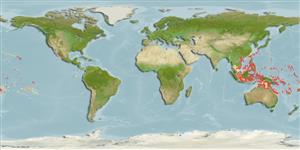>
Eupercaria/misc (Various families in series Eupercaria) >
Labridae (Wrasses) > Corinae
Etymology: Halichoeres: Greek, als, alis = salt + Greek, choiros = pig (Ref. 45335).
More on author: Bleeker.
Environment: milieu / climate zone / depth range / distribution range
Ecología
marino asociado a arrecife; rango de profundidad 2 - 40 m (Ref. 9710). Tropical; 30°N - 24°S
Western Pacific: east to Samoa (Ref. 27362) and Tonga (Ref. 53797).
Tamaño / Peso / Age
Maturity: Lm ? range ? - ? cm
Max length : 13.0 cm SL macho / no sexado; (Ref. 9823)
Short description
Claves de identificación | Morfología | Morfometría
Espinas dorsales (total) : 9; Radios blandos dorsales (total) : 12 - 13; Espinas anales: 3; Radios blandos anales: 12; Vértebra: 25. Anterior head and body color of adults in life bluish gray, shading posteriorly to yellowish; scales often with orange-yellow vertical lines; a dark spot posterior to dorsal half of eye; dorsal fin with a large black spot edged with blue. Anterior lateral line scales with 1-3 pores; 9-11 suborbital pores. Anterior dorsal and anal soft rays longer than posterior rays; pelvic fins of males and large females very long, reaching posterior to anus, often to or beyond origin of anal fin. Juveniles with 4 black stripes on head and body.
Inhabits lagoon and seaward reefs, in coral-rich areas (Ref. 9710). Also found along drop-offs on the bottom of large caves. Usually seen solitary (Ref. 48636).
Life cycle and mating behavior
Maturities | Reproducción | Spawnings | Egg(s) | Fecundities | Larva
Distinct pairing during breeding (Ref. 205).
Randall, J.E., G.R. Allen and R.C. Steene, 1990. Fishes of the Great Barrier Reef and Coral Sea. University of Hawaii Press, Honolulu, Hawaii. 506 p. (Ref. 2334)
IUCN Red List Status (Ref. 130435)
Threat to humans
Harmless
Human uses
Pesquerías: comercial; Acuario: Comercial
Herramientas
Special reports
Download XML
Fuentes de Internet
Estimates based on models
Preferred temperature (Ref.
123201): 25.4 - 28.9, mean 27.7 °C (based on 332 cells).
Phylogenetic diversity index (Ref.
82804): PD
50 = 0.5000 [Uniqueness, from 0.5 = low to 2.0 = high].
Bayesian length-weight: a=0.00955 (0.00451 - 0.02020), b=3.09 (2.92 - 3.26), in cm total length, based on LWR estimates for this Genus-body shape (Ref.
93245).
Nivel trófico (Ref.
69278): 3.5 ±0.5 se; based on size and trophs of closest relatives
Resiliencia (Ref.
120179): Alto, población duplicada en un tiempo mínimo inferior a 15 meses (Preliminary K or Fecundity.).
Fishing Vulnerability (Ref.
59153): Low vulnerability (10 of 100).
Nutrients (Ref.
124155): Calcium = 91.1 [53.6, 154.4] mg/100g; Iron = 0.73 [0.43, 1.35] mg/100g; Protein = 18.4 [15.5, 20.5] %; Omega3 = 0.164 [0.103, 0.259] g/100g; Selenium = 23.7 [14.0, 42.7] μg/100g; VitaminA = 162 [49, 598] μg/100g; Zinc = 1.8 [1.2, 2.9] mg/100g (wet weight);
